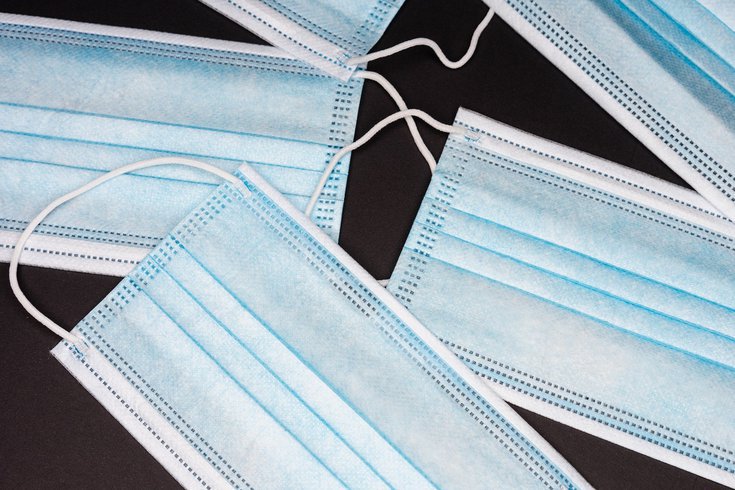
April 11, 2022
 MARKUS WINKLER/PIXABAY
MARKUS WINKLER/PIXABAY
Philadelphia has raised its COVID-19 response level from 'All Clear' to 'Mask Precautions,' which will again require that masks be worn in all indoor public spaces. The change takes effect April 18.
Philadelphia will again require people to wear face masks in indoor public spaces as COVID-19 cases and hospitalizations increase in the city. The change, announced Monday afternoon, is triggered by a series of metrics that guide the city's pandemic response level.
The mask requirement will take effect Monday, April 18, giving businesses and residents one week to adjust.
🧵 Due to increasing COVID-19 cases, @PhiladelphiaGov will move to Level 2: Mask Precautions beginning today. In order to provide a one-week education period for businesses, masks will be required in all indoor public spaces as of Monday, April 18, 2022. (1/4)
— Philadelphia Public Health (@PHLPublicHealth) April 11, 2022
The city has bumped up its COVID response level to Mask Precautions, the second of four tiers. This requires masks in all indoor public areas and businesses. It does not implement any vaccine or testing requirements. Any business that chooses to require vaccination can be exempt from the mask mandate.
"We hope that by having folks masked up whenever they're in public indoor spaces, we can get ahead of the wave and keep it from reaching the peak like we saw in January with the omicron variant," Health Commissioner Dr. Cheryl Bettigole said during a press conference.
Philadelphia's public schools are on spring break this week. Students already had been expected to wear masks during their first week back. The move to the Mask Precautions tier will now apply to schools beyond that period, until the city returns to its All Clear, the least restrictive tier.
The mask mandate also affects large venues such as the Wells Fargo Center, where the Sixers are set to host their first NBA playoff game Saturday, two days before the mask requirement takes effect.
Philadelphia reached an average of 142 COVID-19 cases per day on Monday. There were 46 people being treated for COVID-19 in Philadelphia hospitals.
The city's case rates and hospitalizations remain far lower than during previous peaks of COVID-19, but the health department adopted the response level system in February in order to stay ahead of possible surges and provide a set of transparent metrics that inform guidelines.
Philadelphia switches to the Mask Precautions level when the city's COVID-19 data reaches at least two of these thresholds:
• Average new cases per day are greater than 100.
• Hospitalizations are greater than 50.
• Cases have increased by more than 50% in the previous 10 days.
With the metrics currently right around the line for switching from All Clear to Mask Precautions, the health department will monitor the situation to limit the number of back-and-forth changes between levels. Speaking prior to the city's briefing, health department spokesperson James Garrow said the current numbers indicate another wave of infections.
"Generally, the cases have tended to go in waves, up to a peak, then back down. Our COVID Response Levels were built with that in mind," Garrow said. "If this wave – for whatever reason – acts differently, we would review the metrics used so people don’t have to go through that whipsaw of constantly changing mandates."
The health department reviews all relevant metrics every Monday to determine Philadelphia's response level tier. Overall pandemic conditions also are considered to evaluate whether changes to those metrics are necessary.
The change comes less than a week after Bettigole strongly encouraged Philadelphia residents to resume wearing masks indoors. With the exception of a few settings, the city had lifted the indoor mask requirement and moved to the All Clear stage on March 1 as cases and hospitalizations plummeted after the omicron surge.
The city health department's shift in guidance coincides with the BA.2 omicron variant becoming the dominant coronavirus strain in the country, according to the U.S. Centers for Disease Control and Prevention.
BA.2 is a more contagious omicron variant that spreads about 30% more easily and is believed to be more effective at evading the immune system, according to studies.
Bettigole said the health department doesn't yet have sequencing data to confirm that BA.2 comprises the majority of new infections in Philadelphia, but the city is assuming that is the case.
"I suspect that this wave will be smaller than the one we saw in January, but if we wait to find out to put our masks back on, we'll have lost our chance to stop the wave," Bettigole said.
The CDC relaxed mask-wearing guidance for most Americans in March and has not reinstated broader mask recommendations in response to the BA.2 omicron variant.
Bettigole said the CDC leaves room for the consideration of local conditions and Philadelphia's health department feels its response level system justifies bringing back the indoor mask mandate back to prevent illness among vulnerable populations.
Bettigole acknowledged the hardships that the mask requirement may have on local businesses and residents.
"In the interest of keeping the economic life of the city flowing, the best thing we can do is to keep cases down," Bettigole said. "People tend to react when cases are high much more strongly than they do to something like needing to wear a mask when you walk into a restaurant, but then being able to take it off and enjoy your meal."
Health officials will spend the next several weeks reviewing data to see whether BA.2 is likely to cause a surge in hospitalizations, potentially leading to an uptick in deaths.
"We are constantly looking at these numbers and these metrics are not created with an idea that they would be true forever," Bettigole said. "But we have yet to see a wave of COVID-19 infections that did not result in increasing hospitalizations."
Though most omicron infections were relatively mild, the rate of transmission climbed higher than seen with any previous coronavirus variant. As a result, during the three-month omicron wave, nearly 750 people died in Philadelphia, Bettigole said.
BA.2 already has caused a second wave of omicron cases across parts of Europe and became the dominant strain in South Africa, India and the Philippines. Scientists in the U.S. have been concerned that it could cause another spike in infections here because most states have dropped their COVID-19 restrictions.
Despite the return of Philadelphia's indoor mask requirement, Bettigole said the health department is not overly alarmed by the current trajectory of the pandemic.
"At this level of transmission, we do not believe that there is any reason to panic or to avoid activities we enjoy and that are important to us," Bettigole said. "Our city remains open. By wearing masks consistently, we can continue to go about our daily lives and continue to take part in the life of our city without contributing to increasing transmission of COVID-19."